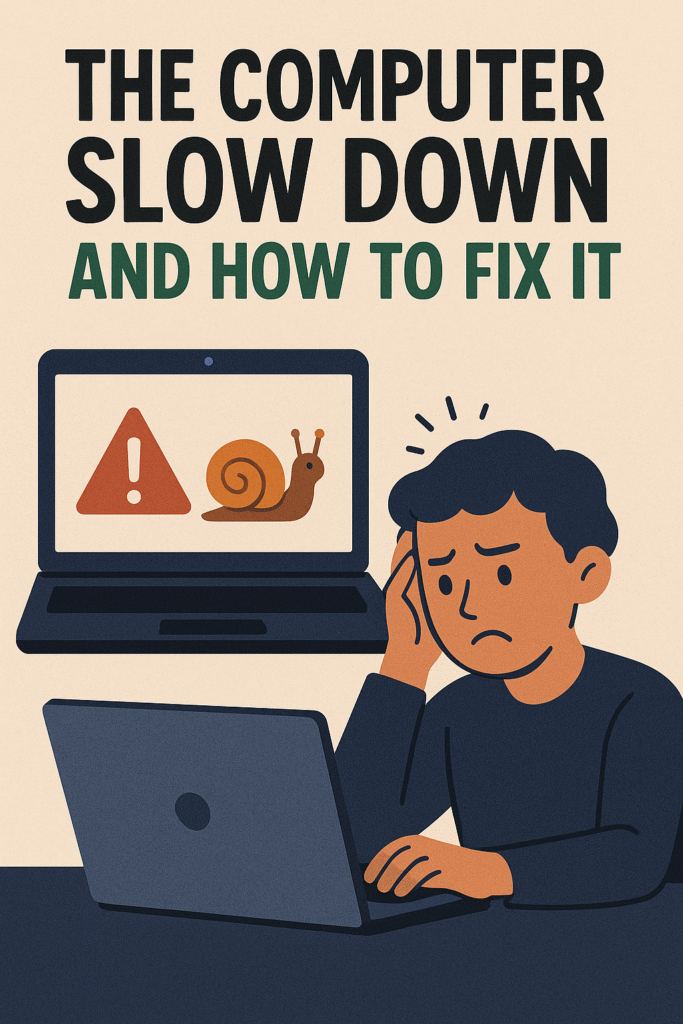In today’s digital age, a computer is an essential part of our daily lives. Whether it’s for office work, studying, freelancing, designing, or video editing — we all rely on a computer that runs smoothly. But many times, we experience a sluggish computer, slow loading times, or even frequent freezing. This not only reduces productivity but also causes frustration.
In this blog, we’ll explore the common reasons behind a slow computer and offer practical solutions to help you speed up your system effectively.
Common Reasons Why Computers Become Slow
1. Insufficient RAM
RAM (Random Access Memory) determines how many tasks your computer can handle simultaneously. If your system doesn’t have enough RAM, it can’t run and also multiple programs smoothly.
Fix:
Upgrade your RAM according to your needs. For Windows 10 or 11, at least 8GB RAM is recommended for a smooth experience.
2. Low Disk Space
If your hard drive is nearly full, the system won’t have enough space for temporary files or virtual memory, which slows down performance.
Fix:
- Delete unnecessary files
- Use Disk Cleanup
- Move large files to an external drive or cloud storage
3. Old HDD Instead of SSD
Traditional Hard Disk Drives (HDDs) are much slower than Solid State Drives (SSDs). An HDD takes more time to read/write data, which causes delays.
Fix:
Upgrade to an SSD. It can drastically improve boot times and application loading speed.
4. Viruses or Malware
Malicious software running in the background can slow down your system, use up resources, and even compromise your data.
Fix:
- Install a reliable antivirus (e.g., Kaspersky, Bitdefender, or built-in Windows Defender)
- Run regular full scans
5. Too Many Startup Programs
Many applications auto-start when you boot your PC, which eats up memory and slows down the startup process.
Fix:
- Press
Ctrl + Shift + Escto open Task Manager - Go to the Startup tab
- Disable unnecessary programs
6. Outdated Operating System or Drivers
Old Windows versions or outdated drivers can cause compatibility issues and lower performance.
Fix:
- Keep Windows updated
- Regularly update device drivers (especially Graphics, Chipset, and Network drivers)
7. Overheating Issues
If your PC is overheating, it may automatically reduce performance to protect its components.
Fix:
- Clean your cooling fan
- Use a laptop cooling pad
- Ensure proper ventilation
8. Clean Your Windows Registry
Over time, Windows registry gets cluttered, which can slow down your computer.
Fix:
Use a safe tool like CCleaner to clean and optimize your registry.
9. Delete Temporary Files and Cache
Applications and browsers generate temp files that accumulate and slow down the system.
Fix:
- Press
Win + R, type%temp%, and delete all files - Clear your browser cache and history
10. Uninstall Unused Software
Unused applications take up space and run background services, affecting performance.
Fix:
Go to Control Panel → Programs → Uninstall a Program
Remove apps you no longer use.
11. Adjust Power Settings
If your PC is in Power Saver mode, performance will be limited to save energy.
Fix:
Go to Control Panel → Power Options → High Performance mode.
Monitor Performance with Useful Tools
These tools can help you understand what’s slowing your system:
- Task Manager – Built-in tool to monitor CPU, RAM, and disk usage
- Process Explorer – Advanced resource monitor from Microsoft
- Speccy – For detailed hardware monitoring
- CrystalDiskInfo – For checking your hard drive’s health
Extra Tips to Keep Your Computer Fast
- Format your system once a year for a fresh start
- Disable unnecessary browser extensions
- Keep your desktop clean with minimal files
- Control background apps that run automatically
- Turn off hibernate if not needed
When Should You Consider Buying a New PC?
If your system shows the following signs even after trying the above fixes, it may be time for an upgrade:
- Takes 2–3 minutes to boot
- Cannot install or run modern software
- Performance doesn’t improve even after upgrading RAM or SSD
- CPU and motherboard are too old (e.g., Core i3 2nd Gen or older)
A slow computer can be annoying, but the good news is — it’s usually fixable. By understanding the root causes and applying the right solutions, you can bring your PC back to life and improve your productivity. Regular maintenance, timely upgrades, and smart system management are key to ensuring your computer runs fast and efficiently.
